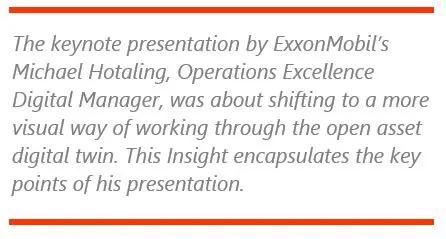

Keywords: ExxonMobil, Open Digital Twins, Ecosystem, Open Process Automation (OPA), Data, Visual, Oil and Gas, ARC Advisory Group.
At the recent ARC Industry Forum in Orlando, the session on Building the Industrial Metaverse on Open Digital Twins brought forth interesting perspectives on the potential value of open digital twins. The keynote presentation by ExxonMobil’s Michael Hotaling,  Operations Excellence Digital Manager, was about shifting to a more visual way of working through the open asset digital twin. To overcome the pinch points and accelerate this move there has to be effective collaboration between all stakeholders: industries, suppliers, and strategic consultants like ARC. The session was skillfully moderated by ARC’s Peter Reynolds.
Operations Excellence Digital Manager, was about shifting to a more visual way of working through the open asset digital twin. To overcome the pinch points and accelerate this move there has to be effective collaboration between all stakeholders: industries, suppliers, and strategic consultants like ARC. The session was skillfully moderated by ARC’s Peter Reynolds.
This session made it clear why organizations must move from present versions of digital twins to open digital twins. Digital twins have improved business performance to some extent, but need an overhaul to become “open” to promote innovation, create value, and remain sustainable. Openness ensures interoperability of data and technologies to ensure cost-effective, scalable, and sustainable solutions. Almost all digital twin implementations have a single use case and business benefit; whereas an open digital twin supports multiple use cases and grows in maturity as use cases are added. Further maturity occurs as the use cases interact with each other, multiplying the benefits.
Michael Hotaling’s presentation traced the ExxonMobil journey to a sustainable asset digital twin and defined the fully mature digital twin, the current and future state of 3D and data, and the pinch points. This Insight encapsulates the key points of his presentation.
Michael spoke about ExxonMobil’s vision of where it is today and where it is likely to be in the future. From an ExxonMobil standpoint it is moving to a more visual way of working. In the oil and gas industry, ExxonMobil is reputed to be the king of data, spreadsheets, multiple decimal points and expects its employees to execute that on the field. But that is unrealistic as the workforce and demographics are changing, so the work processes have to be changed and technologies must be in sync with what consumers demand in their personal lives; and this must be reimagined and realigned with today’s industrial workforce.
The trajectory of open asset digital twins parallels open process automation, explained Michael. In 2015, ExxonMobil had said that the vision of open process automation is to promote innovation and value creation in an ecosystem that has best-in-class components that allow plug and play. In 2023, users and suppliers say that OPA is a standards-based, open, interoperable, secure process automation architecture; and this is what the digital twin ecosystem aims for. In the future, digital twins will be open, standards-based, and use a common federated data model to normalize data from diverse data types or sources and vendors for aggregation and contextualization via the industrial metaverse consumption platforms. “Digital twin in my version is an abstract concept, it’s an ecosystem. Depending on the use case and value the fidelity and frequency may have to change,” said Michael.
The components of the digital twin ecosystem have to work harmoniously. The overlapping relationships in the ecosystem were illustrated via a Venn diagram. Data is central to all operations and makes a digital twin intelligent. There are multiple ways to capture visualization. The data and visualization converges in the center to build this ecosystem of a digital twin. This is an area where there is no single solution, it’s an ecosystem that drives broader uses and value. Hence an environment needs to be built in the industrial facilities to promote innovation and value creation. “To enhance efficiency and reduce carbon emissions we have to think differently,” said Michael. At the 2020 ARC workshop 50 high value cases were identified. In some of the pinch points it’s not so much about creating a digital debt, it’s about ensuring that the asset fits into the way you work, so that the sustainability of those high value cases continues.
ARC Advisory Group clients can view the complete report at the ARC Client Portal.
Please Contact Us if you would like to speak with the author.
Obtain more ARC In-depth Research at Market Analysis

